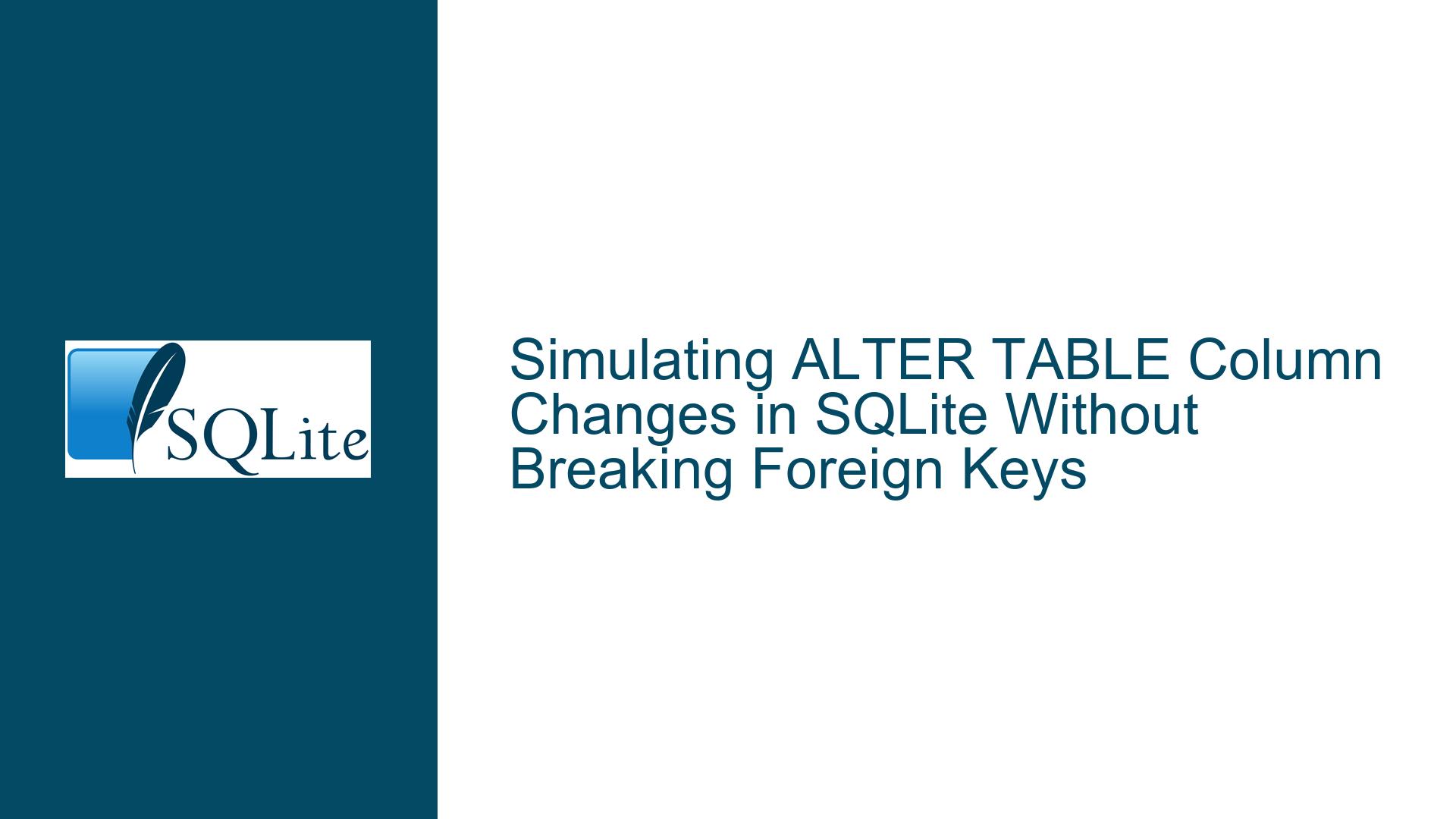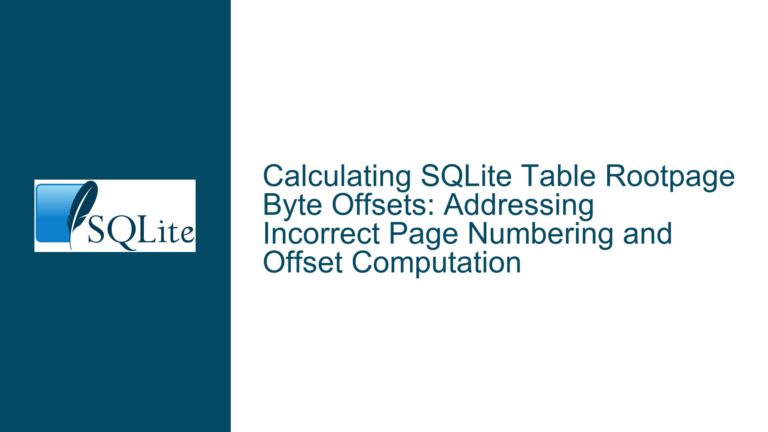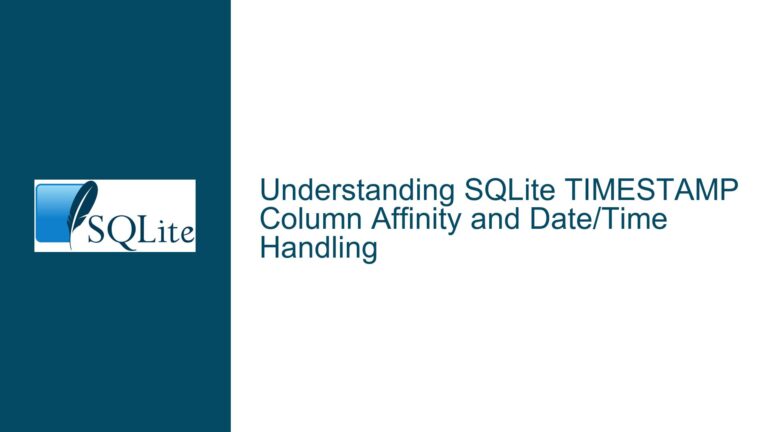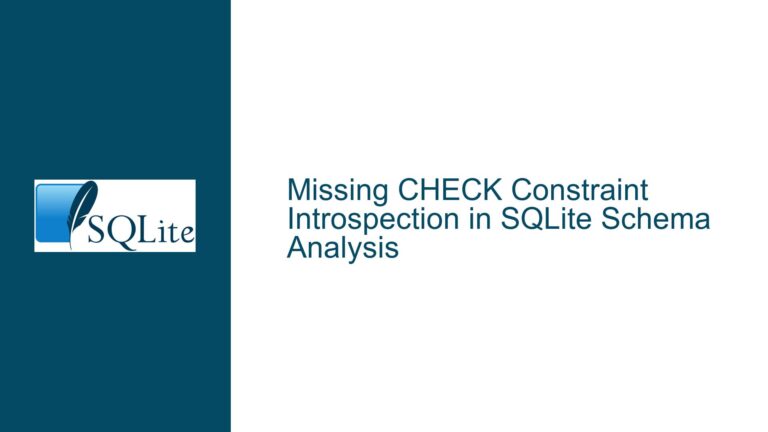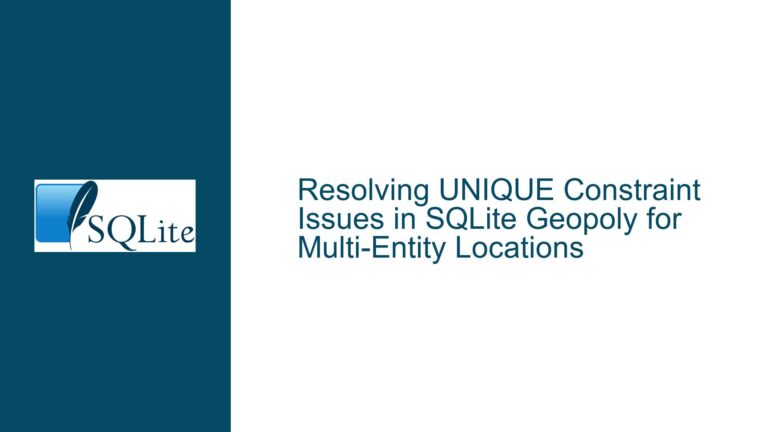Simulating ALTER TABLE Column Changes in SQLite Without Breaking Foreign Keys
Understanding Foreign Key Reference Management During Table Renaming and Schema Modifications
Issue Overview: Risks of Manual Table Renaming to Simulate Column Type Changes
SQLite does not natively support the ALTER TABLE ... ALTER COLUMN command to modify column types or constraints. To work around this limitation, developers often resort to a multi-step process involving table renaming, schema recreation, and data migration. However, this approach introduces complexities when foreign key constraints reference the table being modified. The core challenge lies in executing these schema changes without invalidating existing foreign key relationships or introducing silent failures in constraint enforcement.
When a table (a) is renamed (aa), recreated with a new schema, and its data repopulated, foreign keys in dependent tables (b) must continue pointing to the correct column in the correct table. Two distinct methods emerge from the discussion: one leveraging PRAGMA legacy_alter_table=1 to bypass reference updates during renaming, and another exploiting SQLite’s automatic foreign key reference rewriting through sequential renames. Both approaches risk orphaned references if mishandled, as seen in the example where .schema b initially shows foreign keys referencing a nonexistent aa table after the first rename cycle.
The critical nuance involves SQLite’s handling of object dependencies during ALTER TABLE RENAME. By default, SQLite 3.25.0+ (2018-09-15) introduced behavior where renaming a table automatically updates references in foreign keys, views, and triggers. The legacy_alter_table pragma disables this behavior, freezing references at their original names. Developers must understand how these mechanisms interact with foreign key enforcement states (PRAGMA foreign_keys) to avoid logical inconsistencies in the schema.
Possible Causes: Implicit Reference Updates, Legacy Pragma Side Effects, and Constraint Enforcement Gaps
Unintended Foreign Key Reference Rewriting
Modern SQLite versions automatically update foreign key references during table renames unlessPRAGMA legacy_alter_table=1is active. This creates divergent outcomes:- With
legacy_alter_table=0(default), renamingatoaachangesb’s foreign key froma(id)toaa(id) - With
legacy_alter_table=1,b’s foreign key remainsa(id)despite the table rename
The first method in the discussion uses
legacy_alter_table=1to preserve the original reference name (a) during initial renaming, allowing the recreatedatable to inherit existing foreign keys. However, this requires careful coordination with theforeign_keys=0pragma to suppress constraint checks during data migration. The second method intentionally allows automatic reference updates but manipulates them further through additional renames, creating a brittle dependency on SQLite’s rename propagation logic.- With
Intermittent Constraint Enforcement States
Disabling foreign key checks (PRAGMA foreign_keys=0) is essential during schema modifications to prevent errors from temporarily inconsistent relationships. However, this pragma only affects runtime enforcement – not the schema definition itself. A foreign key pointing to a nonexistent table/column remains valid in the schema (no DDL errors) but will fail whenforeign_keys=1is restored if the target is invalid. Both methods in the discussion risk creating schemas that validate at rest but fail during operation if rename sequences are misordered.Race Conditions in Sequential Rename Operations
The second method’s reliance on double renames (a→aa→a) assumes that SQLite’s reference tracking updates atomically with eachALTER TABLEoperation. In reality, intermediate states expose the schema to dangling references:- After
ALTER TABLE a RENAME TO aa, dependent objects immediately switch to referencingaa - Dropping
aaand recreatingaleaves those references pointing to a nonexistent table - Subsequent renames attempt to repair this but create a window where queries against
bcould reference a missing table
This approach banks on no application accessing the database during the schema transition – a dangerous assumption for systems requiring high availability.
- After
Troubleshooting Steps, Solutions & Fixes: Validating Schema Integrity and Automating Safe Migrations
Step 1: Audit Foreign Key References Before and After Rename Operations
Before modifying any tables, map all foreign key relationships using:
SELECT
m.name AS table_name,
p."table" AS parent_table,
p."from" AS parent_column
FROM sqlite_master m
JOIN pragma_foreign_key_list(m.name) p
WHERE m.type = 'table';
After each ALTER TABLE command, rerun this query to verify reference updates. In the second method, observe that:
- Initial
a→aarename changesb.refidreferences froma(id)toaa(id) - Recreating
aand droppingaaleavesbreferencingaa(id)(invalid) - Renaming
a→aa→arestoresb’s reference toa(id)
This confirms that SQLite’s automatic reference tracking propagates through multiple renames, but only if the final table name matches the original dependency graph.
Step 2: Implement Transactional Guards for Multi-Step Migrations
Wrap the entire schema modification in a transaction with error rollback:
BEGIN;
PRAGMA foreign_keys = 0;
-- Execute rename/recreate steps here
PRAGMA foreign_key_check; -- Must return empty results
PRAGMA foreign_keys = 1;
COMMIT;
If PRAGMA foreign_key_check reports errors after re-enabling foreign keys, the transaction rolls back, preventing partial updates. This is crucial for the second method, where intermediate states violate referential integrity.
Step 3: Use the sqlite-utils Transform Command for Automated Safety
Simon Willison’s sqlite-utils tool automates table recreation with proper foreign key handling:
sqlite-utils transform database.db a \
--rename-column id id \
--type id INTEGER
This command:
- Creates a new table with the desired schema
- Copies data from the old table
- Drops the old table
- Renames the new table to the original name
- Updates all foreign key references atomically
The tool abstracts away manual rename sequencing and ensures that all dependent objects are updated, eliminating the risk of incorrect legacy pragma usage.
Step 4: Validate Index and Trigger Dependencies Post-Migration
Table renames affect more than foreign keys. After migration, check for orphaned triggers or indexes:
SELECT
name,
sql
FROM sqlite_master
WHERE
type IN ('trigger', 'index')
AND sql LIKE '%aa%'; -- Substitute old table name
Any matches indicate incomplete reference updates. Drop and recreate these objects against the new table schema.
Step 5: Benchmark Both Methods Under Load
The manual rename approach may introduce performance cliffs in high-concurrency environments. Test with:
PRAGMA journal_mode = WAL; -- Enable write-ahead logging
-- Simulate concurrent reads during migration
If application queries access the table mid-migration, they may encounter "no such table" errors. The sqlite-utils method minimizes this window but requires exclusive database access. For zero-downtime migrations, consider:
- Deploying a read replica
- Performing the migration on the replica
- Promoting the replica post-migration
Final Recommendation
Prefer automated tools like sqlite-utils transform over manual schema modifications. They encapsulate best practices for reference updates and constraint management, reducing human error. For manual migrations, combine PRAGMA legacy_alter_table=1 with thorough pre/post checks of foreign key integrity. Always test migrations against a production-like dataset to surface hidden dependencies.
